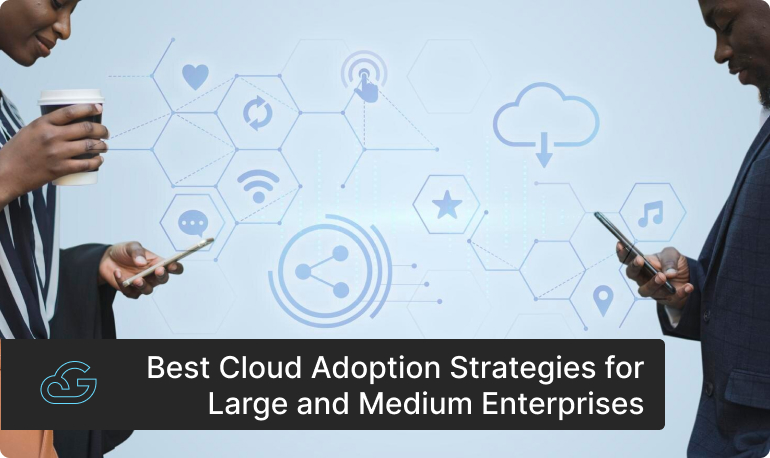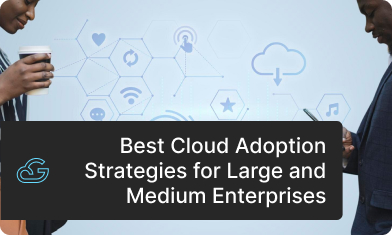Blogs / Cloud Consulting
Best Cloud Adoption Strategies for Large and Medium Enterprises (LMEs)
By
Sherin Job Varghese
Posted: March 15, 2023
• 8 minutes, 49 seconds
Every business today needs cloud migration as a practical IT solution for digital transformation. However, cloud migration is often more complex for LMEs due to challenges such as legacy systems integration, complex regulatory compliance requirements, and organizational change management.
Even though these challenges exist, today, we’re seeing a surge in cloud adoption. LMEs are also jumping on the cloud bandwagon to unlock the benefits of digital transformation. The rise of global business giants such as Facebook Netflix, and Amazon underscores the significance of cloud adoption.
According to Gartner, over the next few
years, cloud computing will continue to evolve from being an innovation
facilitator to a business disruptor and, ultimately, a business
necessity.
Why do LMEs Need a Cloud Adoption Strategy?
So, you're a Large or Medium Enterprise (LME) thinking about diving into the cloud. Great choice! However, the preparation and path for cloud adoption aren't common for all businesses. As an LME, you may have different needs, cultures, and infrastructures, which influence your approach to adopting cloud technologies.
That being said, rushing into cloud adoption without a coherent strategy often leads to cloud sprawl. What would be the pitfalls of a patchwork cloud adoption: complexities, wasteful spending, security vulnerabilities, and compliance chaos. The key to successful cloud migrations hinges on a strategic cloud adoption approach, which means a well-structured plan tailored to your enterprise's needs.
In this blog, we're breaking down everything you need to know about creating the perfect cloud adoption plan - why it matters, different cloud adoption strategies, best practices, and the pro tips for tackling the cloud adoption challenges.
Cloud Adoption Strategies for Large and Medium Enterprises
-
Cloud-First:
Think of this as the "cloud-friendly" approach. In a cloud-first strategy, the emphasis is on prioritizing cloud-based solutions over on-premises alternatives. Here, new applications and solutions are built with the cloud in mind first. Existing on-premises systems might stay put, but the future is definitely cloud based, driven by upcoming IT requirements, flexibility, and innovation. This is a popular choice for LMEs that want to leverage the scalability and agility of the cloud without a complete overhaul.
-
Hybrid Cloud:
Hybrid cloud is like the "best of both worlds" option. This strategy involves leveraging both on-premises data centers and public cloud services. You get to keep your trusty on-premises data center for sensitive information or legacy systems while migrating other workloads to the public cloud. Hybrid cloud adoption would be a good choice, especially for enterprises with existing on-premises infrastructure investments. Hybrid cloud adoption minimizes transformative risk while maximizing commercial benefits, offering flexibility, scalability, and workload portability.
-
Multi-Cloud:
Ever heard of "Don't put all your eggs in one basket?" Multi-cloud is the same idea but applied to cloud providers. Here, you spread your data and applications across multiple cloud platforms. This gives you access to the best-of-breed technologies and services from different providers while reducing dependence on a single vendor. While it presents operational challenges, such as management complexity and data interoperability, multi-cloud adoption offers resilience, redundancy, and the ability to optimize costs across diverse cloud environments.
-
Cloud-Only:
Cloud only is the "all-in" approach that entails relying solely on cloud solutions, typically leveraging public cloud platforms. From infrastructure to software, organizations commit entirely to cloud-based services for their IT needs. It requires a strong foundation of cloud-based solutions (IaaS, PaaS, SaaS) and a commitment to cloud-native development. This approach helps you to utilize the full potential of cloud providers' offerings, such as quick resource scaling, reducing costs, and deploying applications and infrastructure in record time.
-
Cloud-Native:
This isn't just a strategy but rather a design philosophy for applications built specifically for the cloud environment. It helps you to leverage the inherent benefits of cloud technologies such as scalability, resilience, and automation. Cloud-native technologies such as containerization, microservices, and automated deployment – all take advantage of the cloud's inherent strengths. Consider cloud-native development alongside your chosen cloud adoption strategy for optimal results such as faster time-to-market and enhanced agility.
Best Practices for Choosing the Best Cloud Adoption Strategy for LMEs
Each of the above cloud adoption strategies comes with its own set of opportunities and challenges. The best approach depends on your specific needs, existing infrastructure, and risk tolerance. With different cloud adoption strategies out there, picking the perfect combination required continuous guidance and support. To help you get started and ensure a successful cloud adoption, here are some of the best practices for you:
-
Define Your Business Goals and Requirements:
Don't blindly chase the cloud trend. Clearly understand why cloud adoption benefits your specific business. Is it for scalability, cost reduction, or improved application development? Consider your goals, resources, and comfort level with change before choosing your cloud path. This clarity will guide your adoption strategy and ensure alignment with your business needs.
-
Develop a Thorough Cloud Adoption Plan:
Don't wing it! Develop a well-defined plan considering all aspects impacted by cloud adoption. This includes day-to-day operations, personnel training, governance strategies, security, and platform selection. This holistic approach sets the stage for successful implementation and long-term growth.
-
Analyze Financial Implications:
Cloud adoption can be an economic decision. Carefully evaluate costs associated with migrating on-premises infrastructure to the cloud. Compare on-premises and cloud infrastructure expenses, analyze per-user SaaS software costs, factor in subscription models, and plan for ongoing operational costs to ensure they align with your budget.
-
Invest in Employee Education:
A cloud-ready workforce is crucial for success. Invest in training programs to equip your employees with the necessary skills to make use of cloud-based tools effectively. Utilize free resources, online communities, and educational videos to facilitate learning.
-
Prioritize Security and Governance Policies:
Data security should be a top consideration for cloud adoption. Partner with cloud security experts and implement measures like virtual private networks, access restrictions, and data encryption to safeguard your information. A strong governance policy helps prevent sprawl, eliminate waste, and optimize cloud usage in the long run.
-
Start Small and Automate:
Avoid the "big bang" approach. Begin with low-risk, low-cost deployments like test and development systems in the cloud and gradually move others over time. This allows your team to experiment and gain experience before migrating critical workloads. Automate as many tasks as possible, such as configuration, provisioning, and cloud infrastructure management, to reduce manual errors and save time and resources.
-
Partner with a Professional Cloud Service Provider:
Cloud adoption for LMEs can be complex. Partnering with a professional cloud service provider bridges the expertise gap, offering customized solutions, 24/7 support, optimal performance, cost-efficiency, security, and compliance. This allows LMEs to leverage the cloud's full potential for innovation and business growth.
Additional Tips for LMEs:
- When Choosing Cloud Service: Public, private, or hybrid cloud? Consider factors like cost, compliance needs, and internal control requirements. Public cloud might be a good fit for companies with minimal compliance concerns.
- When Choosing a Public Cloud Provider: Among public cloud providers like AWS, Azure, and GCP, compare features, pricing models, and unique offerings to choose the one that best suits your needs.
- Scalability and Flexibility Considerations: Cloud services offer on-demand scalability and flexible resource management. Choose a cloud solution that allows you to adjust resources based on traffic volume and user needs.
Common Challenges in Cloud Adoption for LMEs
While startups can zip right into the cloud, Large and Medium Enterprises (LMEs) face a different story. From migrating complex legacy infrastructure to fostering a culture of innovation and overcoming regulatory compliance hurdles, the path to cloud integration is fraught with some obstacles. Let’s learn them in detail.
-
Migrating Huge Legacy Infrastructure to the Cloud:
LMEs struggle to migrate huge and complex legacy systems to the cloud due to the sheer volume of data involved. Careful planning and execution are crucial for a smooth transition with minimal disruption.
-
Handling Operational Complexity in Multi-Cloud Environments:
Juggling multiple cloud platforms can be tricky for LMEs. Data transfer limitations, fragmented IT operations, and compatibility issues between vendors can create a complex environment that requires careful management.
-
Overcoming Organizational Resistance to Change:
Making the switch to the cloud can sometimes be tough for LMEs because people are used to doing things a certain way. To tackle this, they need to get everyone on the same page, making them aware of how the cloud can help and encourage a more flexible and creative mindset.
-
Ensuring Compliance and Governance in Regulated Industries:
LMEs operating in regulated sectors like finance, healthcare, and government face stringent compliance and data protection regulations. Ensuring alignment with industry standards and maintaining robust governance frameworks demands considerable effort.
-
Prioritizing Data Security and Privacy:
For LMEs managing vast amounts of data, heightened security concerns arise in the cloud. Implementing robust security measures and advanced threat detection becomes crucial to safeguard sensitive information from cyberattacks.
-
Managing Integration Complexity:
Integrating the existing IT landscape with cloud solutions creates a significant struggle for LMEs. Ensuring smooth data flow and application interoperability across hybrid environments adds complexity to cloud adoption.
-
Optimizing ROI and Managing Cost Structures:
LMEs grapple with managing cloud costs effectively. The shift from capital expenditures (CAPEX) for on-premises hardware to a cloud subscription model requires vigilance to avoid cost spirals.
-
Bridging Skill Gaps in Cloud Expertise:
Lack of internal cloud expertise is another challenge faced by many LMEs, which can slow down cloud adoption. To address this, it's crucial to either build a skilled cloud team internally or partner with a managed cloud service provider. This approach helps in managing the transition effectively and optimizing infrastructure costs.
Don't Let Cloud Challenges Hold You Back - Get Started with Gsoft
Cloud adoption can indeed be complex, but at Gsoft Cloud, we're here to simplify the process for LMEs. With our comprehensive cloud consulting services covering Microsoft Azure, Amazon Web Services (AWS), Google Cloud Platform (GCP), and robust private cloud solutions, we help businesses navigate the challenges of cloud migration. Our team of experts will support you every step of the way, offering services such as:
- Assess your existing infrastructure
- Select the right cloud technology
- Develop a secure and scalable digital solution
- Modernize legacy applications
- Migrate your workloads to the cloud
- Build new cloud-native applications
Contact us today for a custom cloud adoption strategy tailored to your organization's needs.


Get Know More About Our Services and Products
Reach to us if you have any queries on any of our products or Services.











